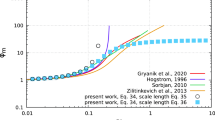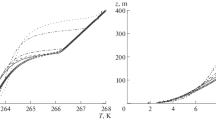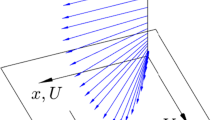Abstract
Here we advance the physical background of the energy- and flux-budget turbulence closures based on the budget equations for the turbulent kinetic and potential energies and turbulent fluxes of momentum and buoyancy, and a new relaxation equation for the turbulent dissipation time scale. The closure is designed for stratified geophysical flows from neutral to very stable and accounts for the Earth’s rotation. In accordance with modern experimental evidence, the closure implies the maintaining of turbulence by the velocity shear at any gradient Richardson number Ri, and distinguishes between the two principally different regimes: “strong turbulence” at \({Ri \ll 1}\) typical of boundary-layer flows and characterized by the practically constant turbulent Prandtl number Pr T; and “weak turbulence” at Ri > 1 typical of the free atmosphere or deep ocean, where Pr T asymptotically linearly increases with increasing Ri (which implies very strong suppression of the heat transfer compared to the momentum transfer). For use in different applications, the closure is formulated at different levels of complexity, from the local algebraic model relevant to the steady-state regime of turbulence to a hierarchy of non-local closures including simpler down-gradient models, presented in terms of the eddy viscosity and eddy conductivity, and a general non-gradient model based on prognostic equations for all the basic parameters of turbulence including turbulent fluxes.
Similar content being viewed by others
Abbreviations
- A i = E i /E K :
-
Share of the ith-component, E i , of turbulent kinetic energy, E K
- E = E K + E P :
-
Total turbulent energy (TTE)
- \({E_{\rm K} = \frac{1}{2}\left\langle {u_i u_i}\right\rangle}\) :
-
Turbulent kinetic energy (TKE)
- E i :
-
Longitudinal (i = 1 or i = x), transverse (i = 2 or i = y) and vertical (i = 3 or i = z) components of TKE
- \({E_\theta = \frac{1}{2}\left\langle {\theta ^{2}}\right\rangle }\) :
-
“Energy” of potential temperature fluctuations
- E P :
-
Turbulent potential energy (TPE), Eq. 28
- \({F_i = \left\langle {u_i \theta}\right\rangle}\) :
-
Turbulent flux of potential temperature
- F z :
-
Vertical component of F i
- \({f = 2\Omega {\rm sin} \varphi}\) :
-
Coriolis parameter
- g :
-
Acceleration due to gravity
- K M :
-
Eddy viscosity, Eq. 43
- K H :
-
Eddy conductivity, Eq. 44
- K D :
-
Eddy diffusivity
- L :
-
Obukhov length scale, Eq. 41
- l :
-
Turbulent length scale
- N :
-
Mean-flow Brunt–Väisälä frequency
- P :
-
Mean pressure
- P 0 :
-
Reference value of P
- p :
-
Fluctuation of pressure
- Pr = ν/κ :
-
Prandtl number
- Pr T :
-
Turbulent Prandtl number, Eq. 45
- Q ij :
-
Correlations between fluctuations of pressure and velocity shear, Eq. 15
- Ri :
-
Gradient Richardson number, Eq. 3
- Ri f :
-
Flux Richardson number, Eq. 40
- R ∞ :
-
Maximal Ri in homogeneous sheared flow
- S = |∂ U/∂ z|:
-
Vertical shear of the horizontal mean wind
- T :
-
Absolute temperature
- T 0 :
-
Reference value of absolute temperature
- \({t_{\rm T} = l E_{\rm K}^{-1/2}}\) :
-
Dissipation time scale
- t τ :
-
Effective dissipation time scale
- U = (U 1, U 2, U 3):
-
Mean wind velocity
- u = (u 1, u 2, u 3):
-
Velocity fluctuation
- β = g/T 0 :
-
Buoyancy parameter
- γ = c p /c v :
-
Ratio of specific heats at constant pressure and constant volume
- \({\varepsilon_{\rm K}, \varepsilon_\theta, \varepsilon_i^{\rm (F)}}\) and \({\varepsilon_{ij}^{(\tau )}}\) :
-
Dissipation rates for \({E_{\rm K}, E_\theta, F_i^{\rm (F)}}\) and τ ij
- \({\varepsilon_{\alpha 3({\rm eff})}^{(\tau)}}\) (α = 1, 2):
-
Effective dissipation rates for the vertical turbulent fluxes of momentum
- κ :
-
Temperature conductivity
- ν :
-
Kinematic viscosity
- Π = E P/E K :
-
Energy stratification parameter, Eq. 74
- ΦK, Φ θ and ΦF :
-
Third-order turbulent fluxes of TKE E K, and the fluxes of E θ and F i
- \({\varphi}\) :
-
Latitude
- τ ij :
-
Reynolds stresses (components of turbulent flux of momentum)
- τ α3 (α = 1, 2):
-
Components of the Reynolds stresses representing the vertical turbulent flux of momentum
- τ :
-
Modulus of the horizontal vector (τ13, τ 23)
- ρ :
-
Mean density
- ρ 0 :
-
Reference value of ρ
- Θ:
-
Mean potential temperature
- θ :
-
Fluctuation of potential temperature
- Ω:
-
Angular velocity of Earth’s rotation
- Ω i :
-
Earth’s rotation vector (parallel to the polar axis)
- C 0 = 0.125:
-
Inter-component energy exchange constant determining the vertical share of TKE, Eqs. 49, 50c
- C 1 = 0.5, C 2 = 0.72:
-
Inter-component energy exchange constants determining the longitudinal and transverse shares of TKE, Eqs. 48– 50
- C F = 0.25:
-
Dissipation time scale constant for the turbulent flux of potential temperature, Eq. 19
- C P = 0.86:
-
Dissipation time-scale constant for the turbulent flux of TPE, Eq. 19
- C r = 1.5:
-
Standard inter-component energy exchange constant, Eqs. 27, 50a, 50b, 50c
- C τ = 0.2:
-
Dissipation time-scale constant for the turbulent flux of momentum, Eq. 33
- C Ω = 1:
-
Rotational length-scale constant, Eq. 73
- R ∞ = 0.25:
-
Upper limit for the flux Richardson number attainable in the steady- state regime of turbulence, Eqs. 40, 46
- k = 0.4:
-
von Karman constant, Eq. 67
- a 1 = 0.18, a 2 = 0.16,:
-
a 3 = 1.42 in Eqs. 81– 86
- C u = k/R ∞ = 1.6:
-
In the velocity gradient formulation, Eq. 70
- C θ = 0.105:
-
In Eqs. 36, 37, 47, 64
- k T = (C F/C τ )k = 0.5:
-
von Karman constant for temperature, Eq. 86
- \({Pr_{\rm T}^{(0)} = 0.8}\) :
-
Turbulent Prandtl number in neutral stratification, Eq. 57
- Π∞ = 0.14:
-
Upper limit for the energy stratification parameter, Eq. 76
References
Angevine WM, Jiang H, Mauritsen T (2010) Performance of an eddy diffusivity–mass flux scheme for shallow cumulus boundary layers. Mon Weather Rev 138: 2895–2912
Banta RM, Newsom RK, Lundquist JK, Pichugina YL, Coulter RL, Mahrt L (2002) Nocturnal low-level jet characteristics over Kansas during CASES-99. Boundary-Layer Meteorol 105: 221–252
Bertin F, Barat J, Wilson R (1997) Energy dissipation rates, eddy diffusivity, and the Prandtl number: an in situ experimental approach and its consequences on radar estimate of turbulent parameters. Radio Sci 32: 791–804
Blackadar AK (1962) The vertical distribution of wind and turbulent exchange in a neutral atmosphere. J Geophys Res 67: 3095–3102
Canuto VM (2002) Critical Richardson numbers and gravity waves. Astron Astrophys 384: 1119–1123
Canuto VM (2009) Turbulence in astrophysical and geophysical flows. Lect Notes Phys 756: 107–160
Canuto VM, Howard A, Cheng Y, Dubovikov MS (2001) Ocean turbulence. Part I: one-point closure model—momentum and heat vertical diffusivities. J. Phys. Oceanogr. 31: 1413–1426
Canuto VM, Cheng Y, Howard AM (2005) What causes the divergences in local second-order closure models?. J Atmos Sci 62: 1645–1651
Canuto VM, Cheng Y, Howard AM, Esau IN (2008) Stably stratified flows: a model with no Ri(cr). J Atmos Sci 65: 2437–2447
Cheng Y, Canuto VM, Howard AM (2002) An improved model for the turbulent PBL. J Atmos Sci 59: 1550–1565
Churchill SW (2002) A reinterpretation of the turbulent Prandtl number. Ind Eng Chem Res 41: 6393–6401
Elperin T, Kleeorin N, Rogachevskii I (1996) Isotropic and anisotropic spectra of passive scalar fluctuations in turbulent fluid flow. Phys Rev E 53: 3431–3441
Elperin T, Kleeorin N, Rogachevskii I, Zilitinkevich S (2002) Formation of large-scale semi-organized structures in turbulent convection. Phys Rev E 66(066305): 1–15
Elperin T, Kleeorin N, Rogachevskii I, Zilitinkevich S (2005) New turbulence closure equations for stable boundary layer. Return to Kolmogorov (1941). In: 5th annual meeting of the European Meteorological Society, Utrecht, The Netherlands, September 12–16, 2005, paper No. 0553
Elperin T, Kleeorin N, Rogachevskii I, Zilitinkevich S (2006) Turbulence and coherent structures in geophysical convection. Boundary-Layer Meteorol 119: 449–472
Engelbart DAM, Andersson S, Görsdorf U, Petenko IV (2000) The Lindenberg SODAR/RASS experiment LINEX-2000: concept and first results. In: Proceedings of 10th international symposium Acoustic Remote Sensing, Auckland, New Zealand, pp 270–273
Esau I (2004) Simulation of Ekman boundary layers by large eddy model with dynamic mixed sub-filter closure. Environ Fluid Mech 4: 273–303
Esau I (2009) Large-eddy simulations of geophysical turbulent flows with applications to planetary boundary layer research, arXiv:0907.0103v1. DATABASE64 could be found on ftp://ftp.nersc.no/igor/NEW%20DATABASE64/
Esau IN, Zilitinkevich SS (2006) Universal dependences between turbulent and mean flow parameters in stably and neutrally stratified planetary boundary layers. Nonlin Process Geophys 13: 135–144
Foken T (2006) 50 years of the Monin–Obukhov similarity theory. Boundary-Layer Meteorol 119: 431–447
Garratt JR (1992) The atmospheric boundary layer. Cambridge University Press, U.K., 316 pp
Glazunov AV (2010) On the effect that the direction of geostrophic wind has on turbulence and quasi-ordered large-eddy structures in the atmospheric boundary layer. Izvestiya RAN, FAO 46: 786–807
Holton JR (2004) An introduction to dynamic meteorology. Academic Press, New York, 535 pp
Itsweire EC, Helland KN, Van Atta CW (1986) The evolution of grid-generated turbulence in a stably stratified fluid. J Fluid Mech 162: 299–338
Kaimal JC, Finnigan JJ (1994) Atmospheric boundary layer flows. Oxford University Press, New York, 289 pp
Kraus EB, Businger JA (1994) Atmosphere–ocean interaction. Oxford University Press, Oxford and New York, 362 pp
Kolmogorov AN (1941) Energy dissipation in locally isotropic turbulence. Doklady AN SSSR 32(1): 19–21
Kolmogorov AN (1942) Equations of turbulent motion in an incompressible fluid. Izv AN SSSR Ser Fiz 6(1–2): 56–58
Kondo J, Kanechika O, Yasuda N (1978) Heat and momentum transfer under strong stability in the atmospheric surface layer. J Atmos Sci 35: 1012–1021
Kurbatsky AF (2000) Lectures on turbulence. Novosibirsk State University Press, Novosibirsk
Kurbatsky AF, Kurbatskaya LI (2006) Three-parameter model of turbulence for the atmospheric boundary layer over an urbanized surface. Izvestiya RAN, FAO 42: 439–455
Kurbatsky AF, Kurbatskaya LI (2009) \({E-\varepsilon-\left\langle {\theta^{2}} \right\rangle}\) turbulence closure model for an atmospheric boundary layer including the urban canopy. Meteorol Atmos Phys 104: 63–81
Kurbatsky AF, Kurbatskaya LI (2010) On the turbulent Prandtl number in a stably stratified atmospheric boundary layer. Izvestiya RAN, FAO 40: 169–177
Lascaux F, Masciardi E, Hagelin S, Stoesz J (2009) Mesoscale optical turbulence simulations at Dome C. I: surface layer thickness and seeing in the free atmosphere. MNRAS 398(849): 193
Lorenz EN (1955) Available potential energy and the maintenance of the general circulation. Tellus 7: 157–167
Lumley JL, Panofsky HA (1964) The structure of atmospheric turbulence. Interscience, New York, 239 pp
L’vov VS, Procaccia I, Rudenko O (2008) Turbulent fluxes in stably stratified boundary layers. Phys Scr T 132(014010): 1–15
L’vov VS, Procaccia I, Rudenko O (2009) Energy conservation and second-order statistics in stably stratified turbulent boundary layers. Environ Fluid Mech 9: 267–295
Mahrt L, Vickers D (2005) Boundary layer adjustment over small-scale changes of surface heat flux. Boundary-Layer Meteorol 116: 313–330
Mauritsen T, Svensson G, Zilitinkevich SS, Esau I, Enger L, Grisogono B (2007) A total turbulent energy closure model for neutrally and stably stratified atmospheric boundary layers. J Atmos Sci 64: 4117–4130
Mellor GL, Yamada T (1974) A hierarchy of turbulence closure models for planetary boundary layers. J Atmos Sci 31: 1791–1806
Monin AS, Obukhov AM (1954) Main characteristics of the turbulent mixing in the atmospheric surface layer. Trudy Geophys Inst AN SSSR 24(151): 153–187
Monin AS, Yaglom AM (1971) Statistical fluid mechanics, vol 1. MIT Press, Cambridge
Mydlarski L (2003) Mixed velocity-passive scalar statistics in high-Reynolds-number turbulence. J. Fluid Mech. 475: 173–203
Nieuwstadt FTM (1984) The turbulent structure of the stable, nocturnal boundary layer. J Atmos Sci 41: 2202–2216
Obukhov AM (1942) On the shape of the turbulent length scale in flows with arbitrary geometry. Institute of Mechanics USSR Academy of Sciences. Appl Math Mech 6: 209–220
Obukhov AM (1946) Turbulence in thermally inhomogeneous atmosphere. Trudy In-ta Teoret Geofiz AN SSSR 1: 95–115
Ohya Y (2001) Wind-tunnel study of atmospheric stable boundary layers over a rough surface. Boundary-Layer Meteorol 98: 57–82
Ostrovsky LA, Troitskaya YuI (1987) A model of turbulent transfer and dynamics of turbulence in a stratified shear flow. Izvestiya AN SSSR FAO 23: 1031–1040
Poulos GS, Blumen W, Fritts DC, Lundquist JK, Sun J, Burns SP, Nappo C, Banta R, Newsom R, Cuxart J, Terradellas E, Balsley B, Jensen M (2002) CASES-99: a comprehensive investigation of the stable nocturnal boundary layer. Bull Am Meteorol Soc 83: 555–581
Rehmann CR, Koseff JR (2004) Mean potential energy change in stratified grid turbulence. Dyn Atmos Oceans 37: 271–294
Richardson LF (1920) The supply of energy from and to atmospheric eddies. Proc R Soc Lond A 97: 354–373
Rogers MM, Mansour NN, Reynolds WC (1989) An algebraic model for the turbulent flux of a passive scalar. J Fluid Mech 203: 77–101
Rotta JC (1951) Statistische theorie nichthomogener turbulenz. Z Physik 129: 547–572
Schumann U, Gerz T (1995) Turbulent mixing in stably stratified shear flows. J Appl Meteorol 34: 33–48
Shih LH, Koseff JR, Ferziger JH, Rehmann CR (2000) Scaling and parameterisation of stratified homogeneous turbulent shear flow. J Fluid Mech 412: 1–20
Sorbjan Z (1989) Structure of the atmospheric boundary layer. Prentice-Hall, Englewood Cliffs, 317 pp
Sorbjan Z (2012) A study of the stable boundary layer based on a single-column K-theory model. Boundary-Layer Meteorol 142: 33–53
Srivat A, Warhaft Z (1983) The effect of a passive cross-stream temperature gradient on the evolution of temperature variance and the heat flux in grid turbulence. J Fluid Mech 128: 323–346
Strang EJ, Fernando HJS (2001) Vertical mixing and transports through a stratified shear layer. J Phys Oceanogr 31: 2026–2048
Stretch DD, Rottman JW, Nomura KK, Venayagamoorthy SK (2001) Transient mixing events in stably stratified turbulence. In: 14th Australasian fluid mechanics conference, Adelaide, Australia, 10–14 December 2001
Sukoriansky S, Galperin B (2008) Anisotropic turbulence and internal waves in stably stratified flows (QNSE theory). Phys Scr T 132(014036): 1–8
Tennekes H, Lumley JL (1972) A first course in turbulence. The MIT Press, Cambridge/London, 300 pp
Uttal T, Curry JA, McPhee MG, Perovich DK, 24 other co-authors (2002) Surface heat budget of the Arctic Ocean. Bull Am Meteorol Soc 83:255–276
Venayagamoorthy SK, Stretch DD (2006) Lagrangian mixing in decaying stably stratified turbulence. J Fluid Mech 564: 197–226
Venayagamoorthy SV, Stretch DD (2010) On the turbulent Prandtl number inhomogeneous stably stratified turbulence. J Fluid Mech 644: 359–369
Yoon KH, Warhaft Z (1990) The evolution of grid-generated turbulence under conditions of stable thermal stratification. J Fluid Mech 215: 601–638
Zilitinkevich SS (2010) Comments on numerical simulation of homogeneous stably stratified turbulence. Boundary-Layer Meteorol 136: 161–164
Zilitinkevich SS, Elperin T, Kleeorin N, Rogachevskii I (2007) Energy- and flux-budget (EFB) turbulence closure model for the stably stratified flows. Part I: steady-state, homogeneous regimes. Boundary-Layer Meteorol 125: 167–192
Zilitinkevich SS, Elperin T, Kleeorin N, Rogachevskii I, Esau I, Mauritsen T, Miles MW (2008) Turbulence energetics in stably stratified geophysical flows: strong and weak mixing regimes. Q J R Meteorol Soc 134: 793–799
Zilitinkevich SS, Elperin T, Kleeorin N, L’vov V, Rogachevskii I (2009) Energy- and flux-budget (EFB) turbulence closure model for stably stratified flows. Part II: the role of internal gravity waves. Boundary-Layer Meteorol 133: 139–164
Zilitinkevich SS, Esau I, Kleeorin N, Rogachevskii I, Kouznetsov RD (2010) On the velocity gradient in the stably stratified sheared flows. Part I: asymptotic analysis and applications. Boundary-Layer Meteorol 135: 505–511
Author information
Authors and Affiliations
Corresponding author
Rights and permissions
About this article
Cite this article
Zilitinkevich, S.S., Elperin, T., Kleeorin, N. et al. A Hierarchy of Energy- and Flux-Budget (EFB) Turbulence Closure Models for Stably-Stratified Geophysical Flows. Boundary-Layer Meteorol 146, 341–373 (2013). https://doi.org/10.1007/s10546-012-9768-8
Received:
Accepted:
Published:
Issue Date:
DOI: https://doi.org/10.1007/s10546-012-9768-8
Keywords
- Boundary layers
- Critical Richardson number
- Eddy viscosity
- Conductivity
- Diffusivity
- Free atmosphere
- Inter-component kinetic energy exchange
- Kinetic potential and total turbulent energies Monin–Obukhov similarity theory
- Stability parameters
- Stable stratification
- Turbulence closure
- Turbulent fluxes
- Turbulent dissipation time and length scales




